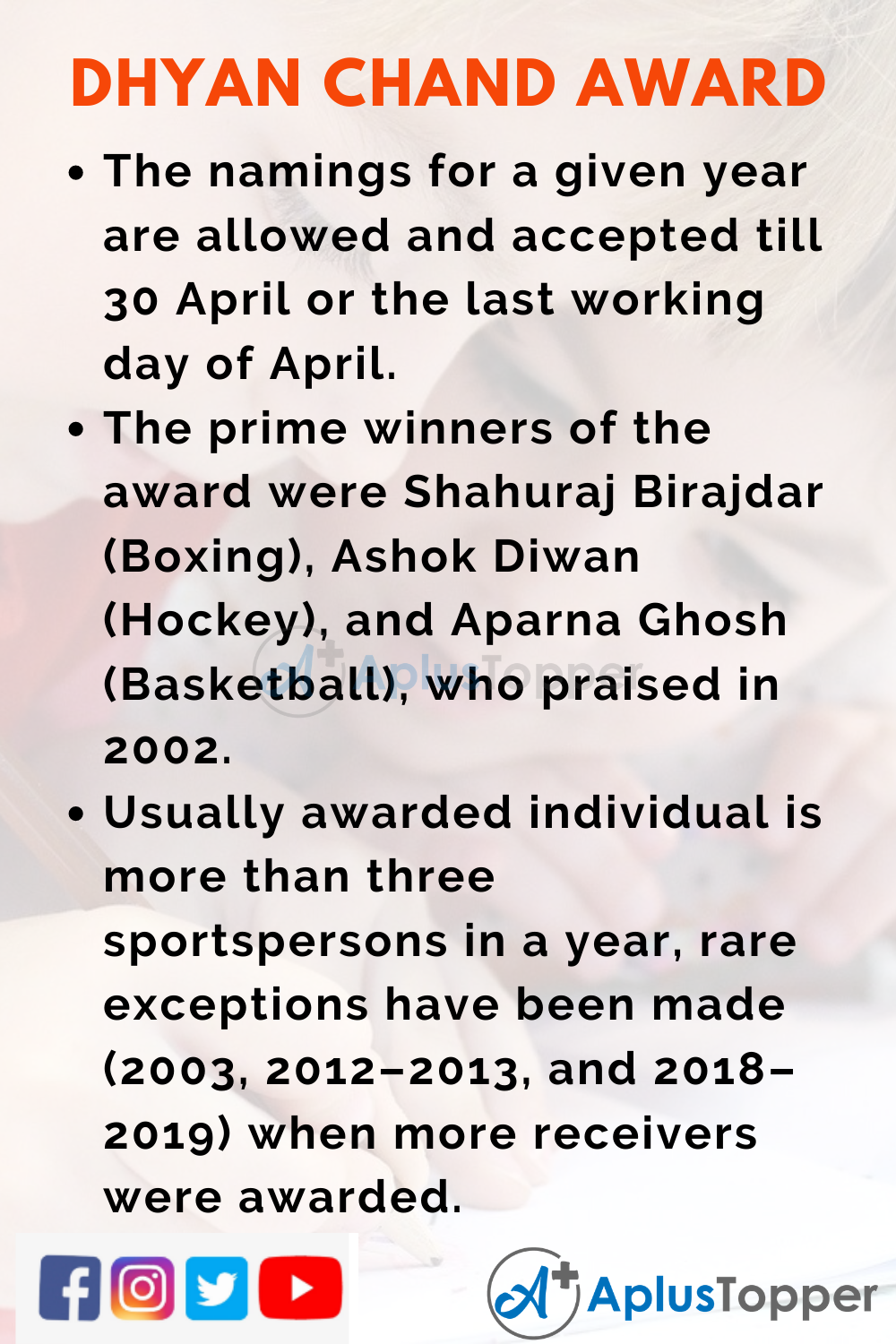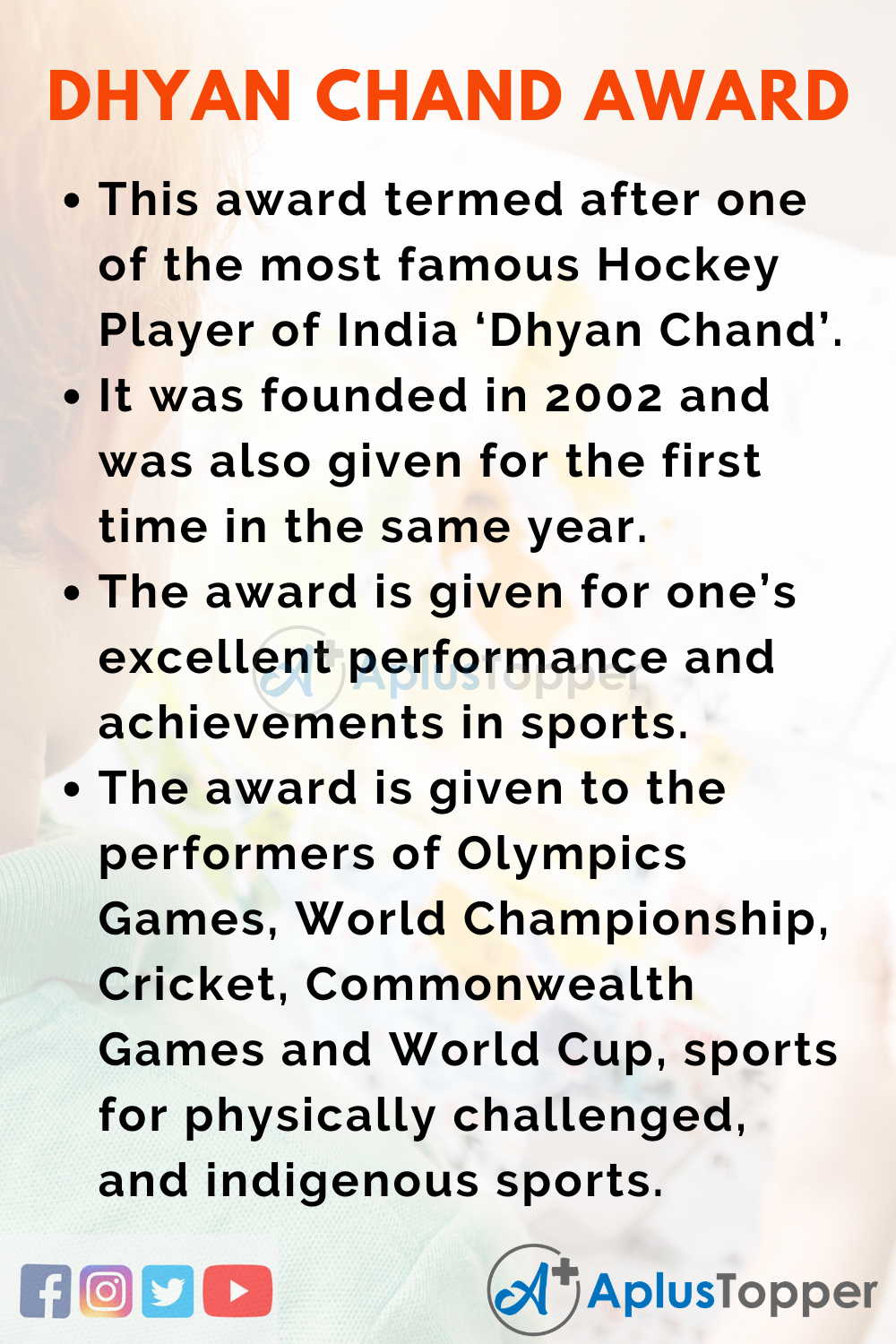10 Lines on Dhyan Chand Award: The Dhyan Chand Award, formally recognized as Dhyan Chand Award for Lifetime Achievement in Sports and Games, is the lifetime achievement sporting honour of the Republic of India. The award defined after Dhyan Chand (1905–79), an Indian field hockey player who got more than 1000 goals throughout a career that spanned over 20 years from 1926 to 1948.
It is awarded yearly by the Ministry of Youth Affairs and Sports. A committee selects receivers constituted by the Ministry and honoured for their contributions to sport both throughout their extraordinary sporting career and after retirement. As of 2019, the award includes a statuette, a certificate, ceremonial dress, and a cash prize of ₹5 lakh. The cash prize changed from ₹3 lakh to ₹5 lakh in 2009.
You can read more 10 Lines about articles, events, people, sports, technology many more.
Set 1 – 10 Lines on Dhyan Chand Award for Kids
Set 1 is helpful for students of Classes 1, 2, 3, 4 and 5.
- Formally the Dhyan Chand Award is termed “Dhyan Chand Award for Lifetime Achievement in Sports and Games.”
- This award termed after one of the most famous Hockey Player of India ‘Dhyan Chand’.
- It was founded in 2002 and was also given for the first time in the same year.
- The award is given for one’s excellent performance and achievements in sports.
- The Government of India is sponsoring the Dhyan Chand Award.
- The award is given to the performers of Olympics Games, World Championship, Cricket, Commonwealth Games and World Cup, sports for physically challenged, and indigenous sports.
- This award mainly includes a statuette, a certificate, and a remarkable cash allowance.
- The cash allowance is set to Rs. 5 lakh for every awardee.
- The statuette presented in the award is of Dhyan Chand and composed of Bronze.
- This award was given by the Ministry of Youth Affairs and Sports.
Set 2 – 10 Lines on Dhyan Chand Award for School Students
Set 2 is helpful for students of Classes 6, 7 and 8.
- Initially, the cash prize for the Dhyan Chand Award was Rs. 3 lakh, which later raised to Rs. 5 lakh in the year 2009.
- The namings for Dhyan Chand Award are presented by various States and Union Territory Governments, Sports Federations, and Previous Sports Award Winners.
- The namings for this award are accepted only till the last working day of April of that year.
- The accepted nomenclatures then transferred to doping test areas for verification.
- A sportsman with any doping charge or investigation is registered null for this award.
- The actual nominations are then transferred to a Selection Committee comprising nine members who think over it.
- After successful confirmation by the Committee, the namings go to the Ministry of Youth Affairs and Sports.
- The primary winners of the Dhyan Chand Award were Ashok Diwan for Hockey, Shahuraj Birajdar for Boxing, and Aparna Ghosh for Basketball.
- The Dhyan Chand Award is usually offered to at most three sportspersons in a year.
- The Dhyan Chand Award is given to sportsperson every year.
Set 3 – 10 Lines on Dhyan Chand Award for Higher School Students
Set 3 is helpful for students of Classes 9, 10, 11, 12 and Competitive Exams.
- Founded in 2002, the award is presented only to the disciplines involved in the events like Olympic Games, Paralympic Games, Asian Games, Commonwealth Games, World Championship and World Cup simultaneously with Cricket, Indigenous Games, and Parasports.
- The namings for a given year are allowed and accepted till 30 April or the last working day of April.
- A nine-member panel decides the nomenclatures and later submits their proposals to the Union Minister of Youth Affairs and Sports for further approval.
- The prime winners of the award were Shahuraj Birajdar (Boxing), Ashok Diwan (Hockey), and Aparna Ghosh (Basketball), who praised in 2002.
- Usually awarded individual is more than three sportspersons in a year, rare exceptions have been made (2003, 2012–2013, and 2018–2019) when more receivers were awarded.
- The submissions for the award received from all government acknowledged by National Sports Federations, the Indian Olympic Association, the Sports Authority of India, the Sports Promotion and Control Boards, and the state and the union territory governments with not more than two qualified sportspersons chosen for each sports discipline.
- All the accepted nominations are transferred to SAI and concerned National Sports Federations for confirmation against the claimed achievements.
- The National Anti-Doping Agency is liable for giving doping clearance.
- The sportsperson with the highest points provided 70 marks, while the other remaining candidates are provided scores in proportion to the most top points.
- For team matches, marks assigned per the power of the team.

FAQ’s on 10 Lines on Dhyan Chand Award
Question 1.
What is the official name of the Dhyan Chand Award?
Answer:
The Dhyan Chand Award, formally recognized as Dhyan Chand Award for Lifetime Achievement in Sports and Games.
Question 2.
Dhyan Chand Award is termed behind which personality?
Answer:
Dhyan Chand is generally acknowledged to be the most skilled hockey player of all time. His goal-scoring capacity was phenomenal, and the opponent defenders were often made to seem like sitting ducks in front of this expert from India.
Question 3.
What is some important information about Dhyan Chand?
Answer:
Chand performed a pivotal role in India, winning three consecutive Olympic gold medals in 1928, 1932, and 1936. His birthday, 29 August, is praised as the National Sports Day in India. The President gives away awards such as Rajiv Gandhi Khel Ratna, Arjuna and Dronacharya awards on this day.
Question 4.
Mention the first winners of the Dhyan Chand award?
Answer:
The first winners of the award were Shahuraj Birajdar (Boxing), Ashok Diwan (Hockey), and Aparna Ghosh (Basketball), who praised in 2002.

